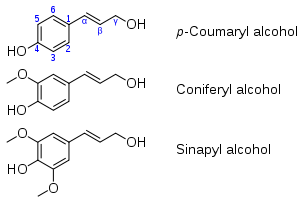
Monolignol
Encyclopedia

Phytochemical
Phytochemicals are biologically active chemical compounds that occur naturally in plants . Phytochemicals are the molecules responsible for the color and organoleptic properties . For example, the deep purple color of blueberries and the smell of garlic...
s acting as source materials for biosynthesis
Biosynthesis
Biosynthesis is an enzyme-catalyzed process in cells of living organisms by which substrates are converted to more complex products. The biosynthesis process often consists of several enzymatic steps in which the product of one step is used as substrate in the following step...
of both lignans and lignin
Lignin
Lignin or lignen is a complex chemical compound most commonly derived from wood, and an integral part of the secondary cell walls of plants and some algae. The term was introduced in 1819 by de Candolle and is derived from the Latin word lignum, meaning wood...
. The starting material for production of monolignols is the amino acid
Amino acid
Amino acids are molecules containing an amine group, a carboxylic acid group and a side-chain that varies between different amino acids. The key elements of an amino acid are carbon, hydrogen, oxygen, and nitrogen...
phenylalanine
Phenylalanine
Phenylalanine is an α-amino acid with the formula C6H5CH2CHCOOH. This essential amino acid is classified as nonpolar because of the hydrophobic nature of the benzyl side chain. L-Phenylalanine is an electrically neutral amino acid, one of the twenty common amino acids used to biochemically form...
. The first reactions in the biosynthesis are shared with the phenylpropanoid
Phenylpropanoid
The phenylpropanoids are a diverse family of organic compounds that are synthesized by plants from the amino acid phenylalanine. Their name is derived from the six-carbon, aromatic phenyl group and the three-carbon propene tail of cinnamic acid, which is synthesized from phenylalanine in the first...
pathway, and monolignols are considered to be a part of this group of compounds. There are three main monolignols: coniferyl alcohol
Coniferyl alcohol
Coniferyl alcohol is an organic compound. This colourless crystalline solid is a phytochemical, one of the monolignols. It is synthethized via the phenylpropanoid biochemical pathway. When copolymerized with related aromatic compounds, coniferyl alcohol forms lignin or lignans...
, sinapyl alcohol
Sinapyl alcohol
Sinapyl alcohol is an organic compound derived from cinnamic acid. This phytochemical is one of the monolignols. It is biosynthetized via the phenylpropanoid biochemical pathway, its immediate precursor being sinapaldehyde. Sinapyl alcohol is a precursor to lignin or lignans. It is also a...
and paracoumaryl alcohol
Paracoumaryl alcohol
Paracoumaryl alcohol, also called p-coumaryl alcohol, 4-coumaryl alcohol, 4-hydroxycinnamyl alcohol, or 4-phenol, is a phytochemical, one of the monolignols. It is synthesized via the phenylpropanoid biochemical pathway...
. Different plant
Plant
Plants are living organisms belonging to the kingdom Plantae. Precise definitions of the kingdom vary, but as the term is used here, plants include familiar organisms such as trees, flowers, herbs, bushes, grasses, vines, ferns, mosses, and green algae. The group is also called green plants or...
s use different monolignols. For example, Norway spruce
Norway Spruce
Norway Spruce is a species of spruce native to Europe. It is also commonly referred to as the European Spruce.- Description :...
lignin is almost entirely coniferyl alcohol
Coniferyl alcohol
Coniferyl alcohol is an organic compound. This colourless crystalline solid is a phytochemical, one of the monolignols. It is synthethized via the phenylpropanoid biochemical pathway. When copolymerized with related aromatic compounds, coniferyl alcohol forms lignin or lignans...
while paracoumaryl alcohol is found almost exclusively in grass
Grass
Grasses, or more technically graminoids, are monocotyledonous, usually herbaceous plants with narrow leaves growing from the base. They include the "true grasses", of the Poaceae family, as well as the sedges and the rushes . The true grasses include cereals, bamboo and the grasses of lawns ...
es.
Monolignols are synthetised in the cytosol
Cytosol
The cytosol or intracellular fluid is the liquid found inside cells, that is separated into compartments by membranes. For example, the mitochondrial matrix separates the mitochondrion into compartments....
as glucoside
Glucoside
A glucoside is a glycoside that is derived from glucose. Glucosides are common in plants, but rare in animals. Glucose is produced when a glucoside is hydrolysed by purely chemical means, or decomposed by fermentation or enzymes....
s. The glucose
Glucose
Glucose is a simple sugar and an important carbohydrate in biology. Cells use it as the primary source of energy and a metabolic intermediate...
is added to the monolignol to make them water soluble and to reduce their toxicity. The glucosides are transported through the cell membrane
Cell membrane
The cell membrane or plasma membrane is a biological membrane that separates the interior of all cells from the outside environment. The cell membrane is selectively permeable to ions and organic molecules and controls the movement of substances in and out of cells. It basically protects the cell...
to the apoplast
Apoplast
Within a plant, the apoplast is the free diffusional space outside the plasma membrane. It is interrupted by the Casparian strip in roots, air spaces between plant cells and the cuticula of the plant....
. The glucose
Glucose
Glucose is a simple sugar and an important carbohydrate in biology. Cells use it as the primary source of energy and a metabolic intermediate...
is then removed and the monolignols are polymerised into lignin.
The phenylpropene
Phenylpropene
Phenylpropenes, propenylphenols or allylbenzenes are a class of phenylpropanoids, a type of polyphenols.The phenylpropenes, including eugenol, chavicol, safrole and estragole, are derived from the monolignols. These compounds are the primary constituents of various essential oils....
s are derived from the monolignols.

